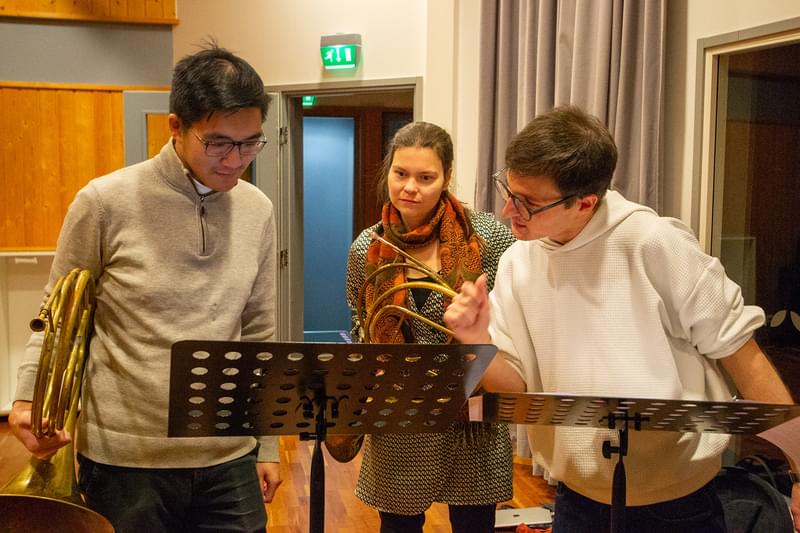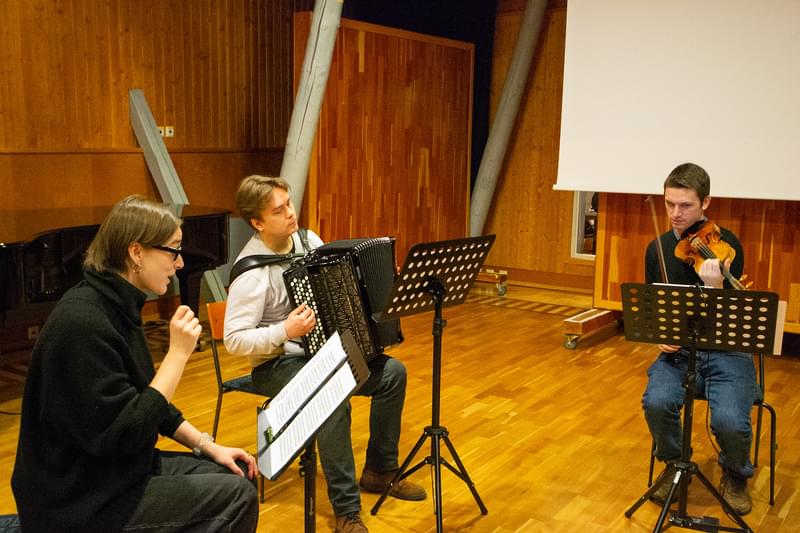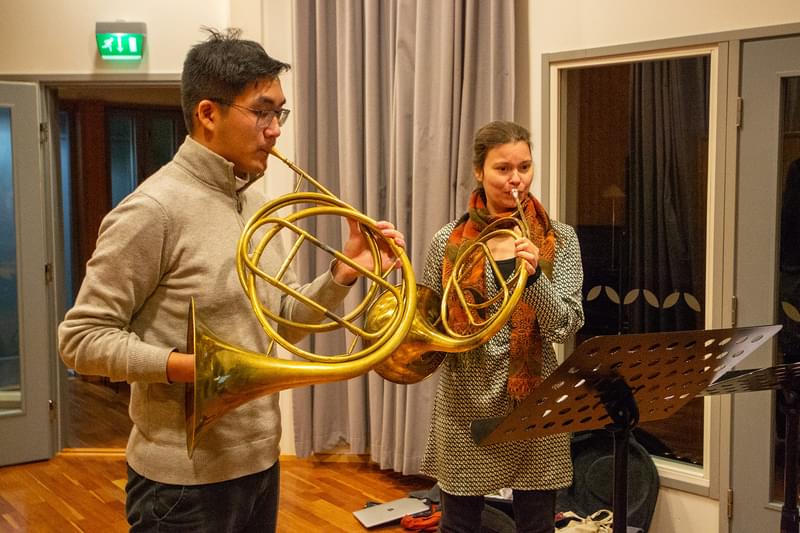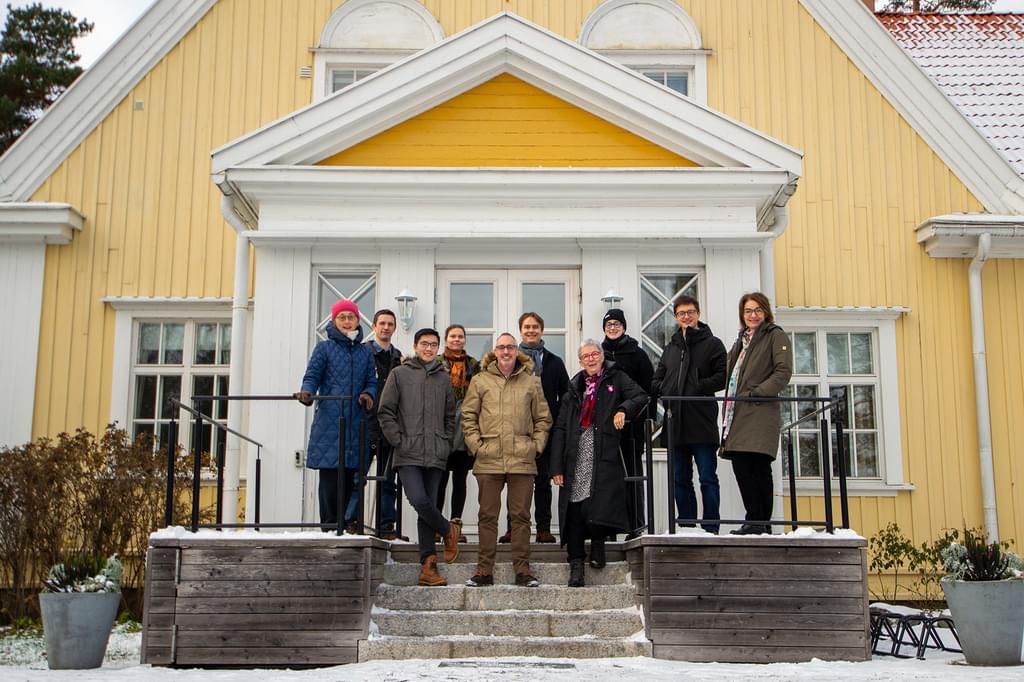
Day 1
On 19 November, we landed in the evening in a dark and snowy Helsinki and were taken directly to Ala-Kuninkala, the summer residence of Sibelius’s daughter, Eva, by Lake Tuusula, 40km away from the capital. The Ala-Kuninkala house is one of several buildings on the Kallio-Kuninkala estate now used by the Sibelius Academy for creative retreats, and includes original furniture, paintings and photographs owned by Sibelius’s family and that of Eva’s husband Arvi Paloheimo - an inspiring setting.
Image: The Barn at Ala-Kuninkala house
Having woken up to a hearty Finnish breakfast, we walked over to begin work at the Barn—the rehearsal, recording and performance complex on the same site. Violinist and Professor of Artistic Research Mieko Kanno gave a brief introduction, and we met our other colleagues from the Sibelius Academy in person for the first time: accordionist Janne Valkeajoki, violinist Sebastian Silén and natural horn player Henriikka Teerikangas – all doctoral students – and mezzo-soprano and University Lecturer Päivi Järviö.

Our first session was led by Victoria and explored our insights as instrumentalists and singers on vocality. Guided by an incisive questionnaire, we listened to a series of excerpts of Handel arias performed by different singers and probed our responses to the performances, reflecting on the ways we described the performances verbally and the assumptions we made about characterisation based on our listening experience and our musical conditioning.
Image: Left to right, Isaac Shieh, Henriikka Teerikangas, James Batty
Following this aural and mental workout, we broke off into two smaller groups for practical workshops. Preparatory discussions with Isaac and Henriikka on microtonal writing for the horn and potential combinations of different crooks, had led to a new composition Tuusula Fanfare. I was excited to workshop this with them as I knew their different research specialisms would raise interesting questions to help finalise the piece - Henriikka’s interest in vocality in 19th-century horn writing and Isaac’s in the creation of new repertoire for the natural horn. It was a thrilling and bizarre experience exploring the intricacies of the horn’s upper range, and the beating sounds between the two instruments, in a reverberant space that had once housed 32 cows and 5 horses.

In parallel with this, the Handel discussions led naturally onto a practical session in which Victoria, Janne and Sebastian played and sang repertoire from Handel’s opera seria and discussed their different perceptions of and approaches to this music—Janne as an accordionist focusing on contemporary classical repertoire and Sebastian as a violinist researching nationalism in Sibelius’s music. This was the first experience for everybody in the room of basso continuo played on the accordion.
Image: Left to right, Victoria Hodgkinson, Janne Valkeajoki, Sebastian Silén
After lunch, Sebastian, Isaac, Sarah and I embarked upon a discussion of nationalism in music, looking at perceptions of Sibelius outside of Finland and the significance of national characteristics – in Finnish, British and other music – when viewed on different scales, from local communities to whole continents. Sibelius’s contemporary Selim Palmgren, who had been a very different and less outspoken kind of nationalist, featured in the discussion, and we discovered that the furniture in the Ylä-Kuninkala building we were in had been bequeathed by him.
Meanwhile, Henriikka led a workshop exploring intricate details of embouchure and articulation and how these are used for musical expression in horn playing. Playing through some practical exercises with Victoria and Janne, they found curious relationships between horn technique, singing and accordion playing.
The conversations continued over dinner and into the evening as the thermometer outside the window – only designed for negative temperatures – descended towards -12°C.
Day 2
The morning began with Sebastian and Victoria expanding on discussions from the day before to address the question of ‘the dancer or the dance’ - specifically how an instrumentalist can deliver a narrative when performing such introspective and personal music as Sibelius’s solo violin pieces from Opus 79 and 80, or how the violinist can act as a narrator or character when performing a work such as the Carmen Fantasy. Victoria offered perspectives on how she experiments with character as a singer, which led to reflections on possible alternative concert formats that might bring storytelling to the fore.
Janne, who has collaborated with a wide range of composers including Magnus Lindberg, led a discussion on composer–performer collaborations, particularly the ingredients of a successful partnership and the instrument as an object of shared investigation. Henriikka, Isaac, David and I had a variety of opinions on this from the perspective of performers and composers, and a fascinating discussion ensued that looked at the optimum balance of isolation and group-work in the collaborative process and the importance of trust in creative partnerships and how this can be built.

The question of whether new solo music is about the instrument itself or a particular player’s practice led to a practical session in the afternoon, where Isaac – whose research is focused on expanding the currently limited solo repertoire for the natural horn – took the opportunity to share some of his commissions, previously only played by him, with another higher-skilled natural horn player. Henriikka raised technical and musical questions in a way that nobody involved in his collaborations had to date and this prompted Mieko to comment on how different and foreign these conversations seemed to a non-horn player—what are the functions of our shared specialist languages as musicians compared with those means of communicating about our artistry more broadly?
Image: Left to right, Isaac Shieh, Henriikka Teerikangas
We concluded these two exhilarating Study Days with a sharing session and agreed that the discussions and workshops had given us all a huge variety of different perspectives to enrich our research and musical practice. Isaac and Henriikka rounded the day off with the premiere performances of my Tuusula Fanfare and David’s newly composed Sundown Signals as we watched the sun set over the frozen lake.
Our gratitude goes to the Mieko, Päivi and the Sibelius Academy for so generously hosting us at Kallio-Kuninkula for these Study Days.
